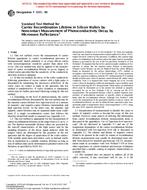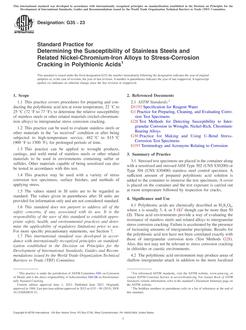
ASTM F1535-00
This standard was transferred to SEMI (www.semi.org) May 2003
1.1 This test method covers the measurement of carrier lifetime appropriate to carrier recombination processes in homogeneously doped, polished, – or -type silicon wafers with room-temperature resistivity greater than about 0.05 [omega][dot]cm. This test method may also be applied to the measurement of carrier recombination lifetime in as-cut, lapped, or etched wafers provided that the sensitivity of the conductivity detection system is adequate.
1.2 In this test method, the decay of the wafer conductivity following generation of excess carriers with a light pulse is determined by monitoring the microwave reflectivity of the wafer. Since no contact is made to the specimen, this test method is nondestructive. If wafer cleanness is maintained, wafers may be further processed following testing by this test method.
1.3 Depending on the level of photoexcitation, the carrier recombination lifetime determined by this test method may be the minority-carrier lifetime (low injection level) or a mixture of minority- and majority-carrier lifetimes (intermediate and high injection levels). In the latter case, the minority and majority carrier lifetimes may be separated under some conditions if a single recombination center that follows the Shockley-Read-Hall model is assumed (see Appendix X1).
1.4 This test method is appropriate for the measurement of carrier recombination lifetimes in the range from 0.25 [mu]s to >1 ms. The shortest measurable lifetime values are governed by the turn-off characteristics of the light source and by the sampling frequency of the decay signal analyzer while the longest values are determined by the geometry of the test specimen and the degree of passivation of the wafer surface. With suitable passivation procedures, such as thermal oxidation or immersion in a suitable solution, lifetimes as long as tens of milliseconds can be determined in polished wafers with thickness as specified in SEMI M1.
Note 1-Carrier recombination lifetime of large bulk specimens can be determined by Method A or B of Test Methods F28. These test methods, which are also based on measurement of photoconductivity decay (PCD), require electrical contacts to the specimen. In addition, they assume large surface recombination on all surfaces and so the upper limit of measurable lifetime is governed by the size of the test specimen. Method B of Test Methods F28 stipulates that the test be carried out under conditions of low injection to ensure that the minority-carrier lifetime is determined. Minority-carrier lifetime can also be deduced from the carrier diffusion length as measured by the surface photovoltage (SPV) method in accordance with Method A or B of Test Methods F391. When carried out under low injection conditions, both the SPV method and the PCD method should yield the same values of minority-carrier lifetime (1) under certain conditions. First, it is required that carrier trapping not occur. Second, correct values of absorption coefficient and minority-carrier mobility must be used in analyzing the SPV measurements. Third, surface recombination effects must be eliminated (as in the present test method) or properly accounted for (as in Test Methods F28) in carrying out the PCD measurements. The generation lifetime, which is another transient characteristic of semiconductor materials, is typically orders of magnitude larger than the recombination lifetime. Although Test Method F1388 covers the measurement of the generation lifetime in silicon wafers, the recombination lifetime can also be deduced from capacitance-time measurements made at temperatures above room temperature ([>=]70°C) using the same MOS capacitor structure (2).
1.5 Interpretation of measurements to identify the cause or nature of impurity centers is beyond the scope of this test method. However, some aspects of deriving this information from carrier recombination lifetime measurements alone is discussed in the appendices. Use of “injection level spectroscopy” (3) are discussed in Appendix X1 and use of the temperature dependence of the carrier recombination lifetime as determined with low-injection level (4) is discussed in Appendix X2. The identity and density of impurity centers found to be present in the wafer by means of recombination lifetime measurements may usually be determined more reliably from deep-level transient spectroscopy (DLTS) measurements made in accordance with Test Method F978 or from other capacitance or current transient spectroscopy techniques provided that a suitable catalog of impurity characteristics is available (5).
1.6 This standard does not purport to address all of the safety concerns, if any, associated with its use. It is the responsibility of the user of this standard to establish appropriate safety and health practices and determine the applicability of regulatory limitations prior to use. Specific hazard statements are given in Section 9.
Product Details
- Published:
- 06/10/2000
- Number of Pages:
- 12
- File Size:
- 1 file , 130 KB

